After months of silence, Voyager 1 has returned NASA’s calls

- Show more sharing options
- Copy Link URL Copied!
For the last five months, it seemed very possible that a 46-year-old conversation had finally reached its end.
Since its launch from Kennedy Space Center on Sept. 5, 1977, NASA’s Voyager 1 spacecraft has diligently sent regular updates to Earth on the health of its systems and data collected from its onboard instruments.
But in November, the craft went quiet.
Voyager 1 is now some 15 billion miles away from Earth. Somewhere in the cold interstellar space between our sun and the closest stars, its flight data system stopped communicating with the part of the probe that allows it to send signals back to Earth. Engineers at the Jet Propulsion Laboratory in La Cañada Flintridge could tell that Voyager 1 was getting its messages, but nothing was coming back.
“We’re to the point where the hardware is starting to age,” said Linda Spilker, the project scientist for the Voyager mission. “It’s like working on an antique car, from 15 billion miles away.”
Week after week, engineers sent troubleshooting commands to the spacecraft, each time patiently waiting the 45 hours it takes to get a response here on Earth — 22.5 hours traveling at the speed of light to reach the probe, and 22.5 hours back.

Science & Medicine

This space artist created the Golden Record and changed the way we see the universe
Space artist Jon Lomberg has produced work that attempts to visualize what we can’t truly see, and to communicate with creatures we can’t yet imagine.
July 26, 2023
By March, the team had figured out that a memory chip that stored some of the flight data system’s software code had failed, turning the craft’s outgoing communications into gibberish.
A long-distance repair wasn’t possible. There wasn’t enough space anywhere in the system to shift the code in its entirety. So after manually reviewing the code line by line, engineers broke it up and tucked the pieces into the available slots of memory.
They sent a command to Voyager on Thursday. In the early morning hours Saturday, the team gathered around a conference table at JPL: laptops open, coffee and boxes of doughnuts in reach.
At 6:41 a.m., data from the craft showed up on their screens. The fix had worked .
“We went from very quiet and just waiting patiently to cheers and high-fives and big smiles and sighs of relief,” Spilker said. “I’m very happy to once again have a meaningful conversation with Voyager 1.”
Voyager 1 is one of two identical space probes. Voyager 2, launched two weeks before Voyager 1, is now about 13 billion miles from Earth, the two crafts’ trajectories having diverged somewhere around Saturn. (Voyager 2 continued its weekly communications uninterrupted during Voyager 1’s outage.)

Space shuttle Endeavour is lifted into the sky, takes final position as star of new museum wing
A shrink-wrapped Endeavour was hoisted and then carefully placed in its final location Tuesday at the still-under-construction Samuel Oschin Air and Space Center.
Jan. 30, 2024
They are the farthest-flung human-made objects in the universe, having traveled farther from their home planet than anything else this species has built. The task of keeping communications going grows harder with each passing day. Every 24 hours, Voyager 1 travels 912,000 miles farther away from us. As that distance grows, the signal becomes slower and weaker.
When the probe visited Jupiter in 1979, it was sending back data at a rate of 115.2 kilobits per second, Spilker said. Today, 45 years and more than 14 billion miles later, data come back at a rate of 40 bits per second.
The team is cautiously optimistic that the probes will stay in contact for three more years, long enough to celebrate the mission’s 50th anniversary in 2027, Spilker said. They could conceivably last until the 2030s.
The conversation can’t last forever. Microscopic bits of silica keep clogging up the thrusters that keep the probes’ antennas pointed toward Earth, which could end communications. The power is running low. Eventually, the day will come when both Voyagers stop transmitting data to Earth, and the first part of their mission ends.
But on the day each craft goes quiet, they begin a new era, one that could potentially last far longer. Each probe is equipped with a metallic album cover containing a Golden Record , a gold-plated copper disk inscribed with sounds and images meant to describe the species that built the Voyagers and the planet they came from.
Erosion in space is negligible; the images could be readable for another billion years or more. Should any other intelligent life form encounter one of the Voyager probes and have a means of retrieving the data from the record, they will at the very least have a chance to figure out who sent them — even if our species is by that time long gone.
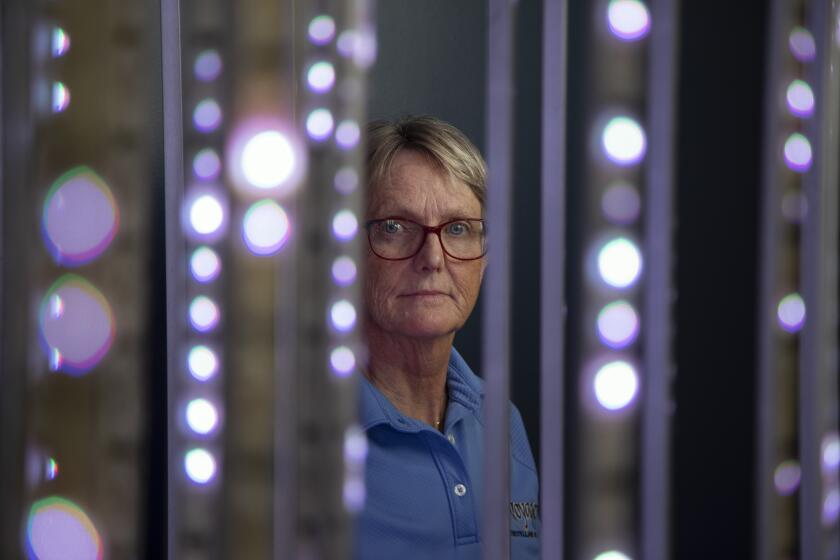
JPL tries to keep Voyager space probes from disconnecting the world’s longest phone call
Keeping in touch with NASA’s two aging Voyager spacecraft is getting harder to do as they get farther away and their power sources dwindle.
Sept. 3, 2022
More to Read

Too expensive, too slow: NASA asks for help with JPL’s Mars Sample Return mission
April 15, 2024

NASA’s attempt to bring home part of Mars is unprecedented. The mission’s problems are not
March 25, 2024
Budget deal for NASA offers glimmer of hope for JPL’s Mars Sample Return mission
March 6, 2024

Corinne Purtill is a science and medicine reporter for the Los Angeles Times. Her writing on science and human behavior has appeared in the New Yorker, the New York Times, Time Magazine, the BBC, Quartz and elsewhere. Before joining The Times, she worked as the senior London correspondent for GlobalPost (now PRI) and as a reporter and assignment editor at the Cambodia Daily in Phnom Penh. She is a native of Southern California and a graduate of Stanford University.
More From the Los Angeles Times

Climate & Environment
You’re gonna need a bigger number: Scientists consider a Category 6 for mega-hurricane era
April 26, 2024

Oldest living MLB player turns 100, vividly recalls facing Dodgers in 1953 World Series

Riverside County deputy, 14 others arrested in drug trafficking bust

Kern County supervisor investigated for allegedly sexually assaulting his child
April 25, 2024
April 22, 2024
After Months of Gibberish, Voyager 1 Is Communicating Well Again
NASA scientists spent months coaxing the 46-year-old Voyager 1 spacecraft back into healthy communication
By Meghan Bartels
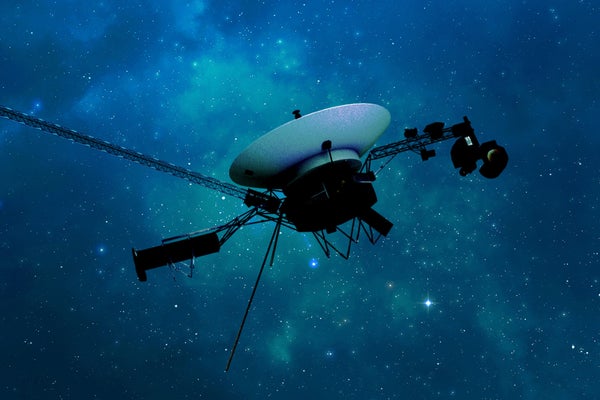
NASA’s Voyager 1 spacecraft is depicted in this artist’s concept traveling through interstellar space, or the space between stars, which it entered in 2012.
NASA/JPL-Caltech
After months of nonsensical transmissions from humanity’s most distant emissary, NASA’s iconic Voyager 1 spacecraft is finally communicating intelligibly with Earth again.
Voyager 1 launched in 1977 , zipped past Jupiter and Saturn within just a few years and has been trekking farther from our sun ever since; the craft crossed into interstellar space in 2012. But in mid-November 2023 Voyager 1’s data transmissions became garbled , sending NASA engineers on a slow quest to troubleshoot the distant spacecraft. Finally, that work has paid off, and NASA has clear information on the probe’s health and status, the agency announced on April 22.
“It’s the most serious issue we’ve had since I’ve been the project manager, and it’s scary because you lose communication with the spacecraft,” said Suzanne Dodd, Voyager project manager at NASA’s Jet Propulsion Laboratory in an interview with Scientific American when the team was still tracking down the issue.
On supporting science journalism
If you're enjoying this article, consider supporting our award-winning journalism by subscribing . By purchasing a subscription you are helping to ensure the future of impactful stories about the discoveries and ideas shaping our world today.
The Voyager 1 spacecraft is a scientific legend : It discovered that Jupiter’s moon Io, far from being a dead world like our own companion, is instead a supervolcanic world . The craft’s data suggested that Saturn’s moon Titan might have liquid on its surface. And for more than a decade, Voyager 1 has given scientists a glimpse at what space looks like beyond the influence of our sun.
Yet its long years in the harsh environment of space have done a number on the probe, which was designed to last just four years. In particular, degraded performance and low power supplies have forced NASA to turn off six of its 10 instruments, and its communication has gotten even spottier than can be explained by the fact that cosmic mechanics mean a signal takes nearly one Earth day to travel between humans and the probe.
When the latest communications glitch occurred last fall, scientists could still send signals to the distant probe, and they could tell that the spacecraft was operating. But all they got from Voyager 1 was gibberish—what NASA described in December 2023 as “a repeating pattern of ones and zeros.” The team was able to trace the issue back to a part of the spacecraft’s computer system called the flight data subsystem, or FDS, and identified that a particular chip within that system had failed.
Mission personnel couldn’t repair the chip. They were, however, able to break the code held on the failed chip into pieces they could tuck into spare corners of the FDS’s memory, according to NASA. The first such fix was transmitted to Voyager 1 on April 18. With a total distance of 30 billion miles to cross from Earth to the spacecraft and back, the team had to wait nearly two full days for a response from the probe. But on April 20 NASA got confirmation that the initial fix worked. Additional commands to rewrite the rest of the FDS system’s lost code are scheduled for the coming weeks, according to the space agency, including commands that will restore the spacecraft’s ability to send home science data.
Although, for now, Voyager 1 appears to be on the mend, NASA scientists know it won’t last forever. Sooner or later, a glitch they can’t fix will occur, or the spacecraft’s ever dwindling fuel supply will run out for good. Until then NASA is determined to get as much data as possible out of the venerable spacecraft—and its twin, Voyager 2, which experienced its own communications glitch earlier in 2023 .
- Mobile Site
- Staff Directory
- Advertise with Ars
Filter by topic
- Biz & IT
- Gaming & Culture
Front page layout
22.5 light hours —
Recoding voyager 1—nasa’s interstellar explorer is finally making sense again, "we're pretty much seeing everything we had hoped for, and that's always good news.”.
Stephen Clark - Apr 23, 2024 5:56 pm UTC
Engineers have partially restored a 1970s-era computer on NASA's Voyager 1 spacecraft after five months of long-distance troubleshooting, building confidence that humanity's first interstellar probe can eventually resume normal operations.
Several dozen scientists and engineers gathered Saturday in a conference room at NASA's Jet Propulsion Laboratory, or connected virtually, to wait for a new signal from Voyager 1. The ground team sent a command up to Voyager 1 on Thursday to recode part of the memory of the spacecraft's Flight Data Subsystem (FDS) , one of the probe's three computers.
“In the minutes leading up to when we were going to see a signal, you could have heard a pin drop in the room," said Linda Spilker, project scientist for NASA's two Voyager spacecraft at JPL. "It was quiet. People were looking very serious. They were looking at their computer screens. Each of the subsystem (engineers) had pages up that they were looking at, to watch as they would be populated."
Finally, a breakthrough
Launched nearly 47 years ago, Voyager 1 is flying on an outbound trajectory more than 15 billion miles (24 billion kilometers) from Earth, and it takes 22-and-a-half hours for a radio signal to cover that distance at the speed of light. This means it takes nearly two days for engineers to uplink a command to Voyager 1 and get a response.
In November, Voyager 1 suddenly stopped transmitting its usual stream of data containing information about the spacecraft's health and measurements from its scientific instruments. Instead, the spacecraft's data stream was entirely unintelligible. Because the telemetry was unreadable, experts on the ground could not easily tell what went wrong. They hypothesized the source of the problem might be in the memory bank of the FDS.
There was a breakthrough last month when engineers sent up a novel command to "poke" Voyager 1's FDS to send back a readout of its memory. This readout allowed engineers to pinpoint the location of the problem in the FDS memory . The FDS is responsible for packaging engineering and scientific data for transmission to Earth.
After a few weeks, NASA was ready to uplink a solution to get the FDS to resume packing engineering data. This data stream includes information on the status of the spacecraft—things like power levels and temperature measurements. This command went up to Voyager 1 through one of NASA's large Deep Space Network antennas Thursday.
Then, the wait for a response. Spilker, who started working on Voyager right out of college in 1977, was in the room when Voyager 1's signal reached Earth Saturday.
"When the time came to get the signal, we could clearly see all of a sudden, boom, we had data, and there were tears and smiles and high fives," she told Ars. "Everyone was very happy and very excited to see that, hey, we're back in communication again with Voyager 1. We're going to see the status of the spacecraft, the health of the spacecraft, for the first time in five months."

Throughout the five months of troubleshooting, Voyager's ground team continued to receive signals indicating the spacecraft was still alive. But until Saturday, they lacked insight into specific details about the status of Voyager 1.
“It’s pretty much just the way we left it," Spilker said. "We're still in the initial phases of analyzing all of the channels and looking at their trends. Some of the temperatures went down a little bit with this period of time that's gone on, but we're pretty much seeing everything we had hoped for. And that's always good news.”
Relocating code
Through their investigation, Voyager's ground team discovered a single chip responsible for storing a portion of the FDS memory stopped working, probably due to either a cosmic ray hit or a failure of aging hardware. This affected some of the computer's software code.
"That took out a section of memory," Spilker said. "What they have to do is relocate that code into a different portion of the memory, and then make sure that anything that uses those codes, those subroutines, know to go to the new location of memory, for access and to run it."
Only about 3 percent of the FDS memory was corrupted by the bad chip, so engineers needed to transplant that code into another part of the memory bank. But no single location is large enough to hold the section of code in its entirety, NASA said.
So the Voyager team divided the code into sections for storage in different places in the FDS. This wasn't just a copy-and-paste job. Engineers needed to modify some of the code to make sure it will all work together. "Any references to the location of that code in other parts of the FDS memory needed to be updated as well," NASA said in a statement.
reader comments
Channel ars technica.
NASA's Voyager 1 spacecraft finally phones home after 5 months of no contact
On Saturday, April 5, Voyager 1 finally "phoned home" and updated its NASA operating team about its health.

NASA's interstellar explorer Voyager 1 is finally communicating with ground control in an understandable way again. On Saturday (April 20), Voyager 1 updated ground control about its health status for the first time in 5 months. While the Voyager 1 spacecraft still isn't sending valid science data back to Earth, it is now returning usable information about the health and operating status of its onboard engineering systems.
Thirty-five years after its launch in 1977, Voyager 1 became the first human-made object to leave the solar system and enter interstellar space . It was followed out of our cosmic quarters by its space-faring sibling, Voyager 2 , six years later in 2018. Voyager 2, thankfully, is still operational and communicating well with Earth.
The two spacecraft remain the only human-made objects exploring space beyond the influence of the sun. However, on Nov. 14, 2023, after 11 years of exploring interstellar space and while sitting a staggering 15 billion miles (24 billion kilometers) from Earth, Voyager 1's binary code — computer language composed of 0s and 1s that it uses to communicate with its flight team at NASA — stopped making sense.
Related: We finally know why NASA's Voyager 1 spacecraft stopped communicating — scientists are working on a fix
In March, NASA's Voyager 1 operating team sent a digital "poke" to the spacecraft, prompting its flight data subsystem (FDS) to send a full memory readout back home.
This memory dump revealed to scientists and engineers that the "glitch" is the result of a corrupted code contained on a single chip representing around 3% of the FDS memory. The loss of this code rendered Voyager 1's science and engineering data unusable.

The NASA team can't physically repair or replace this chip, of course, but what they can do is remotely place the affected code elsewhere in the FDS memory. Though no single section of the memory is large enough to hold this code entirely, the team can slice it into sections and store these chunks separately. To do this, they will also have to adjust the relevant storage sections to ensure the addition of this corrupted code won't cause those areas to stop operating individually, or working together as a whole. In addition to this, NASA staff will also have to ensure any references to the corrupted code's location are updated.
Get the Space.com Newsletter
Breaking space news, the latest updates on rocket launches, skywatching events and more!
— Voyager 2: An iconic spacecraft that's still exploring 45 years on
— NASA's interstellar Voyager probes get software updates beamed from 12 billion miles away
— NASA Voyager 2 spacecraft extends its interstellar science mission for 3 more years
On April 18, 2024, the team began sending the code to its new location in the FDS memory. This was a painstaking process, as a radio signal takes 22.5 hours to traverse the distance between Earth and Voyager 1, and it then takes another 22.5 hours to get a signal back from the craft.
By Saturday (April 20), however, the team confirmed their modification had worked. For the first time in five months, the scientists were able to communicate with Voyager 1 and check its health. Over the next few weeks, the team will work on adjusting the rest of the FDS software and aim to recover the regions of the system that are responsible for packaging and returning vital science data from beyond the limits of the solar system.
Join our Space Forums to keep talking space on the latest missions, night sky and more! And if you have a news tip, correction or comment, let us know at: [email protected].

Robert Lea is a science journalist in the U.K. whose articles have been published in Physics World, New Scientist, Astronomy Magazine, All About Space, Newsweek and ZME Science. He also writes about science communication for Elsevier and the European Journal of Physics. Rob holds a bachelor of science degree in physics and astronomy from the U.K.’s Open University. Follow him on Twitter @sciencef1rst.
Boeing Starliner 1st astronaut flight: Live updates
'Rocket cam' takes you aboard final launch of ULA's Delta IV Heavy (video)
5 sci-fi movies that weren't great but still deserve a sequel
- Robb62 'V'ger must contact the creator. Reply
- Holy HannaH! Couldn't help but think that "repair" sounded extremely similar to the mechanics of DNA and the evolution of life. Reply
- Torbjorn Larsson *Applause* indeed, thanks to the Voyager teams for the hard work! Reply
- SpaceSpinner I notice that the article says that it has been in space for 35 years. Either I have gone back in time 10 years, or their AI is off by 10 years. V-*ger has been captured! Reply
Admin said: On Saturday, April 5, Voyager 1 finally "phoned home" and updated its NASA operating team about its health. The interstellar explorer is back in touch after five months of sending back nonsense data. NASA's Voyager 1 spacecraft finally phones home after 5 months of no contact : Read more
evw said: I'm incredibly grateful for the persistence and dedication of the Voyagers' teams and for the amazing accomplishments that have kept these two spacecrafts operational so many years beyond their expected lifetimes. V-1 was launched when I was 25 years young; I was nearly delirious with joy. Exploring the physical universe captivated my attention while I was in elementary school and has kept me mesmerized since. I'm very emotional writing this note, thinking about what amounts to a miracle of technology and longevity in my eyes. BRAVO!!! THANK YOU EVERYONE PAST & PRESENT!!!
- EBairead I presume it's Fortran. Well done all. Reply
SpaceSpinner said: I notice that the article says that it has been in space for 35 years. Either I have gone back in time 10 years, or their AI is off by 10 years. V-*ger has been captured!
EBairead said: I presume it's Fortran. Well done all.
- View All 11 Comments
Most Popular
- 2 James Webb Space Telescope discovers some early universe galaxies grew up surprisingly fast
- 3 Alien Day 2024: 'Alien' bursts back into theaters today
- 4 Satellite images overlay 2024 and 2017 total solar eclipses sweeping across US
- 5 Boeing's Starliner spacecraft is 'go' for May 6 astronaut launch
- Skip to main content
- Keyboard shortcuts for audio player
Well, hello, Voyager 1! The venerable spacecraft is once again making sense

Nell Greenfieldboyce

Members of the Voyager team celebrate at NASA's Jet Propulsion Laboratory after receiving data about the health and status of Voyager 1 for the first time in months. NASA/JPL-Caltech hide caption
Members of the Voyager team celebrate at NASA's Jet Propulsion Laboratory after receiving data about the health and status of Voyager 1 for the first time in months.
NASA says it is once again able to get meaningful information back from the Voyager 1 probe, after months of troubleshooting a glitch that had this venerable spacecraft sending home messages that made no sense.
The Voyager 1 and Voyager 2 probes launched in 1977 on a mission to study Jupiter and Saturn but continued onward through the outer reaches of the solar system. In 2012, Voyager 1 became the first spacecraft to enter interstellar space, the previously unexplored region between the stars. (Its twin, traveling in a different direction, followed suit six years later.)
Voyager 1 had been faithfully sending back readings about this mysterious new environment for years — until November, when its messages suddenly became incoherent .

NASA's Voyager 1 spacecraft is talking nonsense. Its friends on Earth are worried
It was a serious problem that had longtime Voyager scientists worried that this historic space mission wouldn't be able to recover. They'd hoped to be able to get precious readings from the spacecraft for at least a few more years, until its power ran out and its very last science instrument quit working.
For the last five months, a small team at NASA's Jet Propulsion Laboratory in California has been working to fix it. The team finally pinpointed the problem to a memory chip and figured out how to restore some essential software code.
"When the mission flight team heard back from the spacecraft on April 20, they saw that the modification worked: For the first time in five months, they have been able to check the health and status of the spacecraft," NASA stated in an update.
The usable data being returned so far concerns the workings of the spacecraft's engineering systems. In the coming weeks, the team will do more of this software repair work so that Voyager 1 will also be able to send science data, letting researchers once again see what the probe encounters as it journeys through interstellar space.

After a 12.3 billion-mile 'shout,' NASA regains full contact with Voyager 2
- interstellar mission

- The Contents
- The Making of
- Where Are They Now
- Frequently Asked Questions
- Q & A with Ed Stone
golden record
Where are they now.
- frequently asked questions
- Q&A with Ed Stone
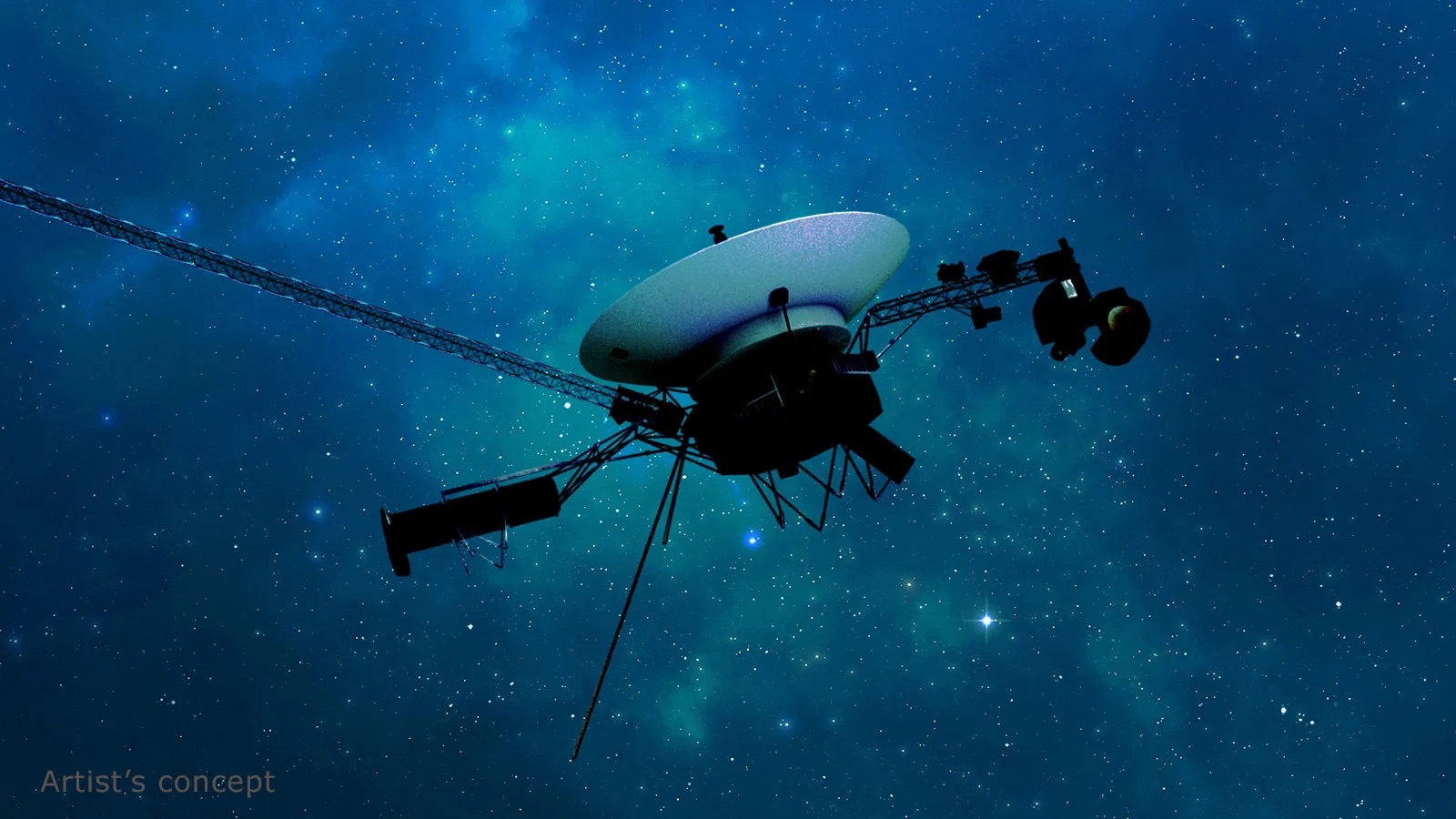
NASA’s Voyager Team Focuses on Software Patch, Thrusters

NASA Mission Update: Voyager 2 Communications Pause
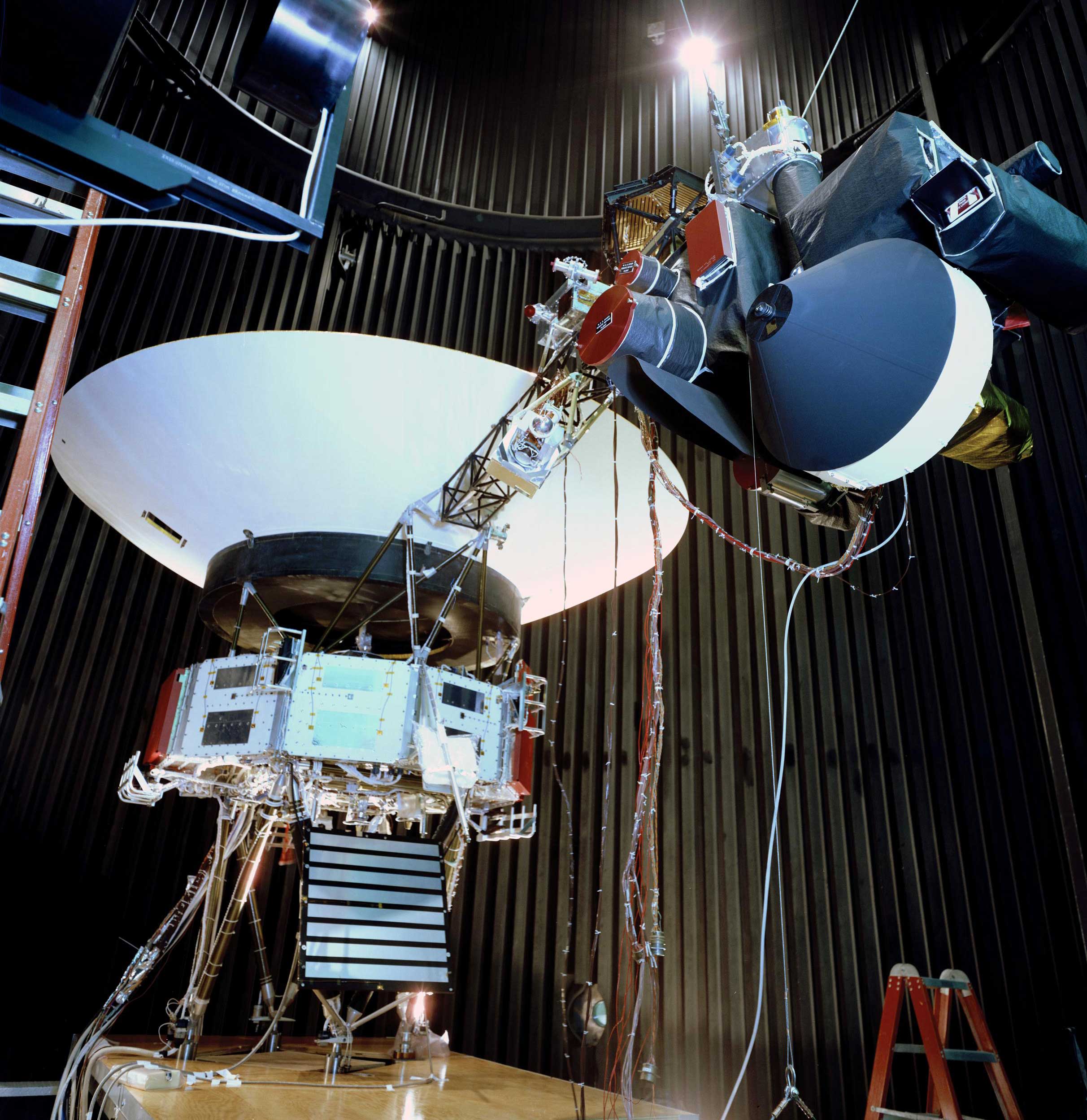
NASA's Voyager Will Do More Science With New Power Strategy
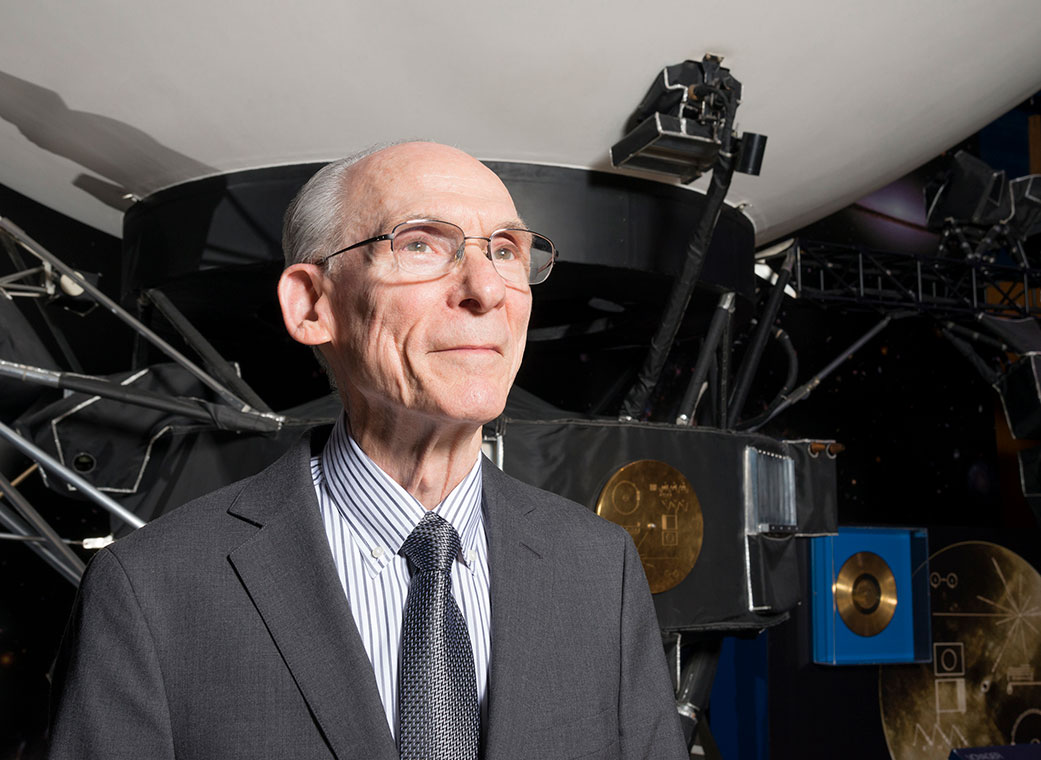
Edward Stone Retires After 50 Years as NASA Voyager's Project Scientist
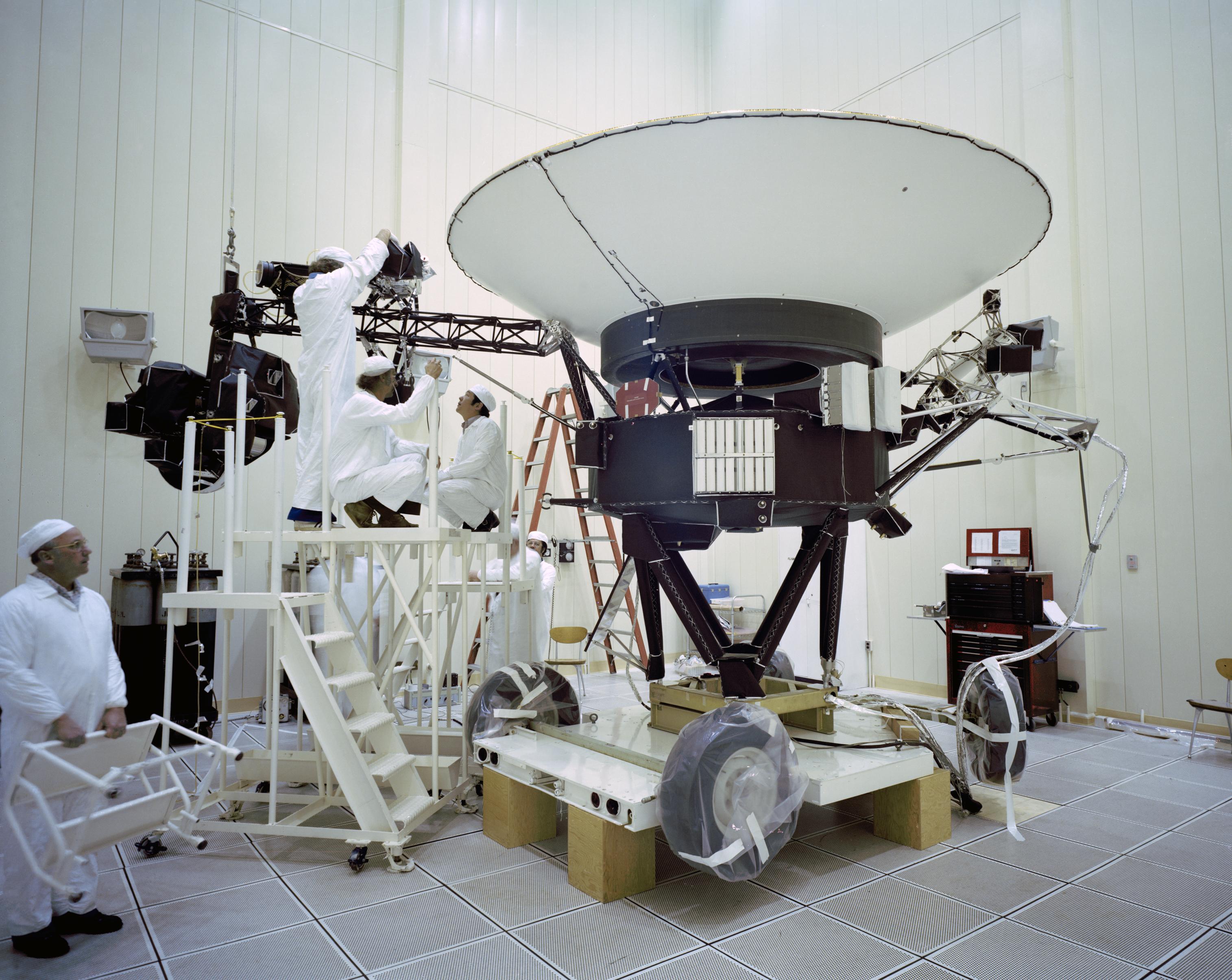
Voyager, NASA's Longest-Lived Mission, Logs 45 Years in Space
Voyager 1 distance from earth, voyager 1 distance from sun, voyager 1 one-way light time, voyager 1 cosmic ray data, voyager 2 distance from the earth, voyager 2 distance from the sun, voyager 2 one-way light time, voyager 2 cosmic ray data, what's happening now.
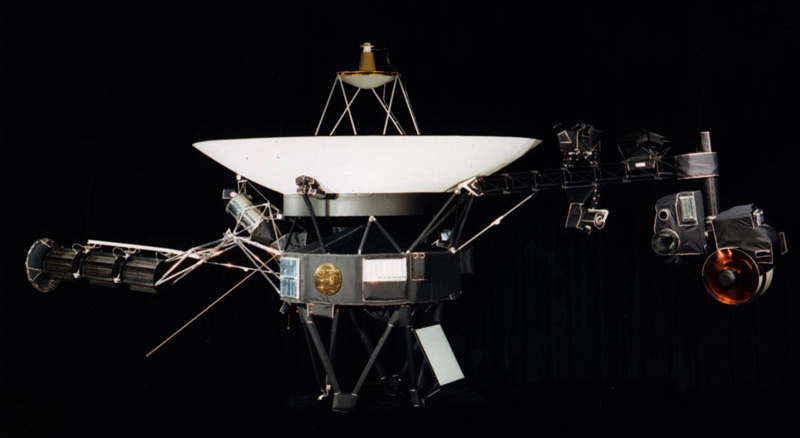
Since November 2023, NASA’s Voyager 1 spacecraft has been sending a steady radio signal to Earth, but the signal does not contain usable data.
Engineers are working to resolve an issue with one of Voyager 1’s three onboard computers, called the flight data system (FDS).
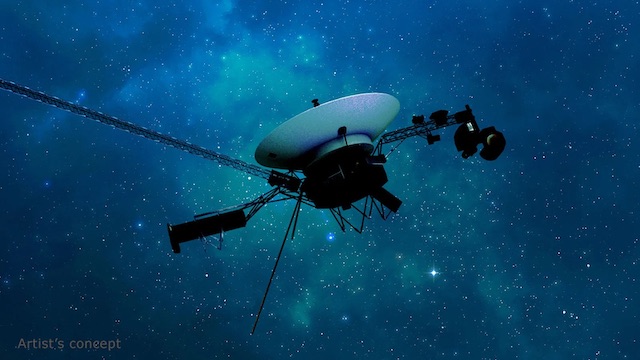
The efforts should help extend the lifetimes of the agency's interstellar explorers.

Download the Voyager 40th Anniversary posters.
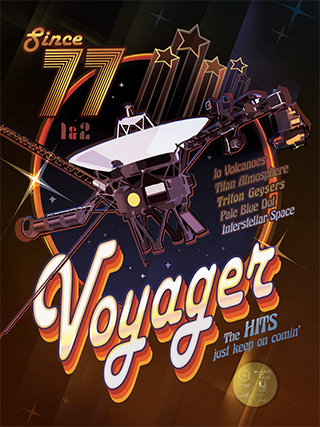
- Share full article
Advertisement
Supported by
Voyager 1, First Craft in Interstellar Space, May Have Gone Dark
The 46-year-old probe, which flew by Jupiter and Saturn in its youth and inspired earthlings with images of the planet as a “Pale Blue Dot,” hasn’t sent usable data from interstellar space in months.

By Orlando Mayorquin
When Voyager 1 launched in 1977, scientists hoped it could do what it was built to do and take up-close images of Jupiter and Saturn. It did that — and much more.
Voyager 1 discovered active volcanoes, moons and planetary rings, proving along the way that Earth and all of humanity could be squished into a single pixel in a photograph, a “ pale blue dot, ” as the astronomer Carl Sagan called it. It stretched a four-year mission into the present day, embarking on the deepest journey ever into space.
Now, it may have bid its final farewell to that faraway dot.
Voyager 1 , the farthest man-made object in space, hasn’t sent coherent data to Earth since November. NASA has been trying to diagnose what the Voyager mission’s project manager, Suzanne Dodd, called the “most serious issue” the robotic probe has faced since she took the job in 2010.
The spacecraft encountered a glitch in one of its computers that has eliminated its ability to send engineering and science data back to Earth.
The loss of Voyager 1 would cap decades of scientific breakthroughs and signal the beginning of the end for a mission that has given shape to humanity’s most distant ambition and inspired generations to look to the skies.
“Scientifically, it’s a big loss,” Ms. Dodd said. “I think — emotionally — it’s maybe even a bigger loss.”
Voyager 1 is one half of the Voyager mission. It has a twin spacecraft, Voyager 2.
Launched in 1977, they were primarily built for a four-year trip to Jupiter and Saturn , expanding on earlier flybys by the Pioneer 10 and 11 probes.
The Voyager mission capitalized on a rare alignment of the outer planets — once every 175 years — allowing the probes to visit all four.
Using the gravity of each planet, the Voyager spacecraft could swing onto the next, according to NASA .
The mission to Jupiter and Saturn was a success.
The 1980s flybys yielded several new discoveries, including new insights about the so-called great red spot on Jupiter, the rings around Saturn and the many moons of each planet.
Voyager 2 also explored Uranus and Neptune , becoming in 1989 the only spacecraft to explore all four outer planets.

Voyager 1, meanwhile, had set a course for deep space, using its camera to photograph the planets it was leaving behind along the way. Voyager 2 would later begin its own trek into deep space.
“Anybody who is interested in space is interested in the things Voyager discovered about the outer planets and their moons,” said Kate Howells, the public education specialist at the Planetary Society, an organization co-founded by Dr. Sagan to promote space exploration.
“But I think the pale blue dot was one of those things that was sort of more poetic and touching,” she added.
On Valentine’s Day 1990, Voyager 1, darting 3.7 billion miles away from the sun toward the outer reaches of the solar system, turned around and snapped a photo of Earth that Dr. Sagan and others understood to be a humbling self-portrait of humanity.
“It’s known the world over, and it does connect humanity to the stars,” Ms. Dodd said of the mission.
She added: “I’ve had many, many many people come up to me and say: ‘Wow, I love Voyager. It’s what got me excited about space. It’s what got me thinking about our place here on Earth and what that means.’”
Ms. Howells, 35, counts herself among those people.
About 10 years ago, to celebrate the beginning of her space career, Ms. Howells spent her first paycheck from the Planetary Society to get a Voyager tattoo.
Though spacecraft “all kind of look the same,” she said, more people recognize the tattoo than she anticipated.
“I think that speaks to how famous Voyager is,” she said.
The Voyagers made their mark on popular culture , inspiring a highly intelligent “Voyager 6” in “Star Trek: The Motion Picture” and references on “The X Files” and “The West Wing.”
Even as more advanced probes were launched from Earth, Voyager 1 continued to reliably enrich our understanding of space.
In 2012, it became the first man-made object to exit the heliosphere, the space around the solar system directly influenced by the sun. There is a technical debate among scientists around whether Voyager 1 has actually left the solar system, but, nonetheless, it became interstellar — traversing the space between stars.
That charted a new path for heliophysics, which looks at how the sun influences the space around it. In 2018, Voyager 2 followed its twin between the stars.
Before Voyager 1, scientific data on the sun’s gases and material came only from within the heliosphere’s confines, according to Dr. Jamie Rankin, Voyager’s deputy project scientist.
“And so now we can for the first time kind of connect the inside-out view from the outside-in,” Dr. Rankin said, “That’s a big part of it,” she added. “But the other half is simply that a lot of this material can’t be measured any other way than sending a spacecraft out there.”
Voyager 1 and 2 are the only such spacecraft. Before it went offline, Voyager 1 had been studying an anomalous disturbance in the magnetic field and plasma particles in interstellar space.
“Nothing else is getting launched to go out there,” Ms. Dodd said. “So that’s why we’re spending the time and being careful about trying to recover this spacecraft — because the science is so valuable.”
But recovery means getting under the hood of an aging spacecraft more than 15 billion miles away, equipped with the technology of yesteryear. It takes 45 hours to exchange information with the craft.
It has been repeated over the years that a smartphone has hundreds of thousands of times Voyager 1’s memory — and that the radio transmitter emits as many watts as a refrigerator lightbulb.
“There was one analogy given that is it’s like trying to figure out where your cursor is on your laptop screen when your laptop screen doesn’t work,” Ms. Dodd said.
Her team is still holding out hope, she said, especially as the tantalizing 50th launch anniversary in 2027 approaches. Voyager 1 has survived glitches before, though none as serious.
Voyager 2 is still operational, but aging. It has faced its own technical difficulties too.
NASA had already estimated that the nuclear-powered generators of both spacecrafts would likely die around 2025.
Even if the Voyager interstellar mission is near its end, the voyage still has far to go.
Voyager 1 and its twin, each 40,000 years away from the next closest star, will arguably remain on an indefinite mission.
“If Voyager should sometime in its distant future encounter beings from some other civilization in space, it bears a message,” Dr. Sagan said in a 1980 interview .
Each spacecraft carries a gold-plated phonograph record loaded with an array of sound recordings and images representing humanity’s richness, its diverse cultures and life on Earth.
“A gift across the cosmic ocean from one island of civilization to another,” Dr. Sagan said.
Orlando Mayorquin is a general assignment and breaking news reporter based in New York. More about Orlando Mayorquin
What’s Up in Space and Astronomy
Keep track of things going on in our solar system and all around the universe..
Never miss an eclipse, a meteor shower, a rocket launch or any other 2024 event that’s out of this world with our space and astronomy calendar .
Scientists may have discovered a major flaw in their understanding of dark energy, a mysterious cosmic force . That could be good news for the fate of the universe.
A new set of computer simulations, which take into account the effects of stars moving past our solar system, has effectively made it harder to predict Earth’s future and reconstruct its past.
Dante Lauretta, the planetary scientist who led the OSIRIS-REx mission to retrieve a handful of space dust , discusses his next final frontier.
A nova named T Coronae Borealis lit up the night about 80 years ago. Astronomers say it’s expected to put on another show in the coming months.
Is Pluto a planet? And what is a planet, anyway? Test your knowledge here .
Voyager 1 had a problem. Here's how NASA fixed it from 15 billion miles away.
Working from more than 15 billion miles away, NASA engineers have solved a computer problem aboard Voyager 1 , allowing the probe to send readable data five months after a chip error made its transmissions impossible to decipher.
Voyager 1, along with its sister craft, Voyager 2, are robotic probes that were launched in 1977. Voyager 1 reached interstellar space in 2012. It's now 15.1 billion miles away, the farthest from Earth a human-made object has ever traveled.
Learn more: Closer look at Voyager 1 and Voyager 2 .
Voyager 2 entered interstellar space − the space between the stars, starting at abou t 11 billion miles from our sun − in 2018. It's now 12.7 billion miles away.
Voyager 1's computer glitch garbled the science and engineering data the craft sends to Earth, which rendered it unreadable. That started on Nov. 14, 2023.
How did engineers fix Voyager's problem?
Engineers from NASA and the Jet Propulsion Laboratory discovered a single computer chip inside the spacecraft’s Flight Data Subsystem – which collects science and engineering information and transmits it to Earth – had malfunctioned.
Can't see our graphics? Click here .
The chip stored part of the Flight Data Subsystem's memory and software code. Engineers could still receive data from Voyager 1, but it was scrambled.
The chip could not be repaired. Instead, engineers moved software code from the chip into a different part of the subsystem's memory system.
The code was too large to to be stored in a single location in the spacecraft. Engineers divided the code into sections and stored them in different places within the subsystem. The code sections were adjusted to make sure they worked as a whole.
Engineers tested the fix by moving a code that transmits data about the spacecraft. They were rewarded with a transmission from Voyager that contained readable data about the craft's status.
All that took time. Voyager is moving about 38,000 mph. Because it's so far away, it takes 22.5 hours for a radio signal to reach Voyager. It takes another 22.5 hours for the spacecraft’s reply to reach antenna networks on Earth.
What happens next?
Engineers will reposition and synchronize the other parts of the code. That should allow Voyager 1 to start sending readable data on what it finds as it moves farther away from Earth.
SOURCE USA TODAY Network reporting and research; NASA/Jet Propulsion Laboratory/California Institute of Technology; Reuters
- Election 2024
- Entertainment
- Newsletters
- Photography
- Personal Finance
- AP Investigations
- AP Buyline Personal Finance
- AP Buyline Shopping
- Press Releases
- Israel-Hamas War
- Russia-Ukraine War
- Global elections
- Asia Pacific
- Latin America
- Middle East
- Election Results
- Delegate Tracker
- AP & Elections
- Auto Racing
- 2024 Paris Olympic Games
- Movie reviews
- Book reviews
- Personal finance
- Financial Markets
- Business Highlights
- Financial wellness
- Artificial Intelligence
- Social Media
NASA hears from Voyager 1, the most distant spacecraft from Earth, after months of quiet
This illustration provided by NASA depicts Voyager 1. The most distant spacecraft from Earth stopped sending back understandable data in November 2023. Flight controllers traced the blank communication to a bad computer chip and rearranged the spacecraft’s coding to work around the trouble. In mid-April 2024, NASA’s Jet Propulsion Laboratory declared success after receiving good engineering updates. The team is still working to restore transmission of the science data. (NASA via AP)
- Copy Link copied
CAPE CANAVERAL, Fla. (AP) — NASA has finally heard back from Voyager 1 again in a way that makes sense.
The most distant spacecraft from Earth stopped sending back understandable data last November. Flight controllers traced the blank communication to a bad computer chip and rearranged the spacecraft’s coding to work around the trouble.
NASA’s Jet Propulsion Laboratory in Southern California declared success after receiving good engineering updates late last week. The team is still working to restore transmission of the science data.
It takes 22 1/2 hours to send a signal to Voyager 1, more than 15 billion miles (24 billion kilometers) away in interstellar space. The signal travel time is double that for a round trip.
Contact was never lost, rather it was like making a phone call where you can’t hear the person on the other end, a JPL spokeswoman said Tuesday.
Launched in 1977 to study Jupiter and Saturn, Voyager 1 has been exploring interstellar space — the space between star systems — since 2012. Its twin, Voyager 2, is 12.6 billion miles (20 billion kilometers) away and still working fine.
The Associated Press Health and Science Department receives support from the Howard Hughes Medical Institute’s Science and Educational Media Group. The AP is solely responsible for all content.

Suggested Searches
- Climate Change
- Expedition 64
- Mars perseverance
- SpaceX Crew-2
- International Space Station
- View All Topics A-Z
Humans in Space
Earth & climate, the solar system, the universe, aeronautics, learning resources, news & events.

NASA Wins 6 Webby Awards, 8 Webby People’s Voice Awards


NASA’s CloudSat Ends Mission Peering Into the Heart of Clouds

Hubble Celebrates 34th Anniversary with a Look at the Little Dumbbell Nebula
- Search All NASA Missions
- A to Z List of Missions
- Upcoming Launches and Landings
- Spaceships and Rockets
- Communicating with Missions
- James Webb Space Telescope
- Hubble Space Telescope
- Why Go to Space
- Astronauts Home
- Commercial Space
- Destinations
- Living in Space
- Explore Earth Science
- Earth, Our Planet
- Earth Science in Action
- Earth Multimedia
- Earth Science Researchers
- Pluto & Dwarf Planets
- Asteroids, Comets & Meteors
- The Kuiper Belt
- The Oort Cloud
- Skywatching
- The Search for Life in the Universe
- Black Holes
- The Big Bang
- Dark Energy & Dark Matter
- Earth Science
- Planetary Science
- Astrophysics & Space Science
- The Sun & Heliophysics
- Biological & Physical Sciences
- Lunar Science
- Citizen Science
- Astromaterials
- Aeronautics Research
- Human Space Travel Research
- Science in the Air
- NASA Aircraft
- Flight Innovation
- Supersonic Flight
- Air Traffic Solutions
- Green Aviation Tech
- Drones & You
- Technology Transfer & Spinoffs
- Space Travel Technology
- Technology Living in Space
- Manufacturing and Materials
- Science Instruments
- For Kids and Students
- For Educators
- For Colleges and Universities
- For Professionals
- Science for Everyone
- Requests for Exhibits, Artifacts, or Speakers
- STEM Engagement at NASA
- NASA's Impacts
- Centers and Facilities
- Directorates
- Organizations
- People of NASA
- Internships
- Our History
- Doing Business with NASA
- Get Involved
- Aeronáutica
- Ciencias Terrestres
- Sistema Solar
- All NASA News
- Video Series on NASA+
- Newsletters
- Social Media
- Media Resources
- Upcoming Launches & Landings
- Virtual Events
- Sounds and Ringtones
- Interactives
- STEM Multimedia

NASA’s ORCA, AirHARP Projects Paved Way for PACE to Reach Space

Hubble Spots a Magnificent Barred Galaxy

NASA’s Optical Comms Demo Transmits Data Over 140 Million Miles

NASA Shares Lessons of Human Systems Integration with Industry

Work Underway on Large Cargo Landers for NASA’s Artemis Moon Missions

NASA Open Science Initiative Expands OpenET Across Amazon Basin

Amendment 11: Physical Oceanography not solicited in ROSES-2024

Sols 4166-4167: A Garden Full of Rocks

Sols 4164-4165: What’s Around the Ridge-bend?

Sols 4161-4163: Double Contact Science

NASA’s Chandra Releases Doubleheader of Blockbuster Hits

Explore the Universe with the First E-Book from NASA’s Fermi

Dr. Douglas Hudgins

NASA Photographer Honored for Thrilling Inverted In-Flight Image

NASA’s Ingenuity Mars Helicopter Team Says Goodbye … for Now

NASA Langley Team to Study Weather During Eclipse Using Uncrewed Vehicles

NASA Data Helps Beavers Build Back Streams

NASA’s Near Space Network Enables PACE Climate Mission to ‘Phone Home’

Washington State High Schooler Wins 2024 NASA Student Art Contest

NASA STEM Artemis Moon Trees

NASA Glenn Joins Big Hoopla STEM Challenge

First NASA Mars Analog Crew Nears End of Mission

Diez maneras en que los estudiantes pueden prepararse para ser astronautas

Astronauta de la NASA Marcos Berríos

Resultados científicos revolucionarios en la estación espacial de 2023
Voyager 1 launches aboard titan iii/centaur.

NASA’s Voyager 1 spacecraft launched atop its Titan/Centaur-6 launch vehicle from the Kennedy Space Center Launch Complex in Florida on September 5, 1977, at 8:56 a.m. local time.
The twin Voyager 1 and 2 spacecraft are still operating and traveling where no spacecraft – or anything touched by humanity – has gone before. As we celebrate the 40th anniversary of the Voyager 1 launch, we reflect on the vision that inspired the mission, its greatest achievements, and its enduring legacy.
Image Credit: NASA

News | December 1, 2017
Voyager 1 fires up thrusters after 37 years.
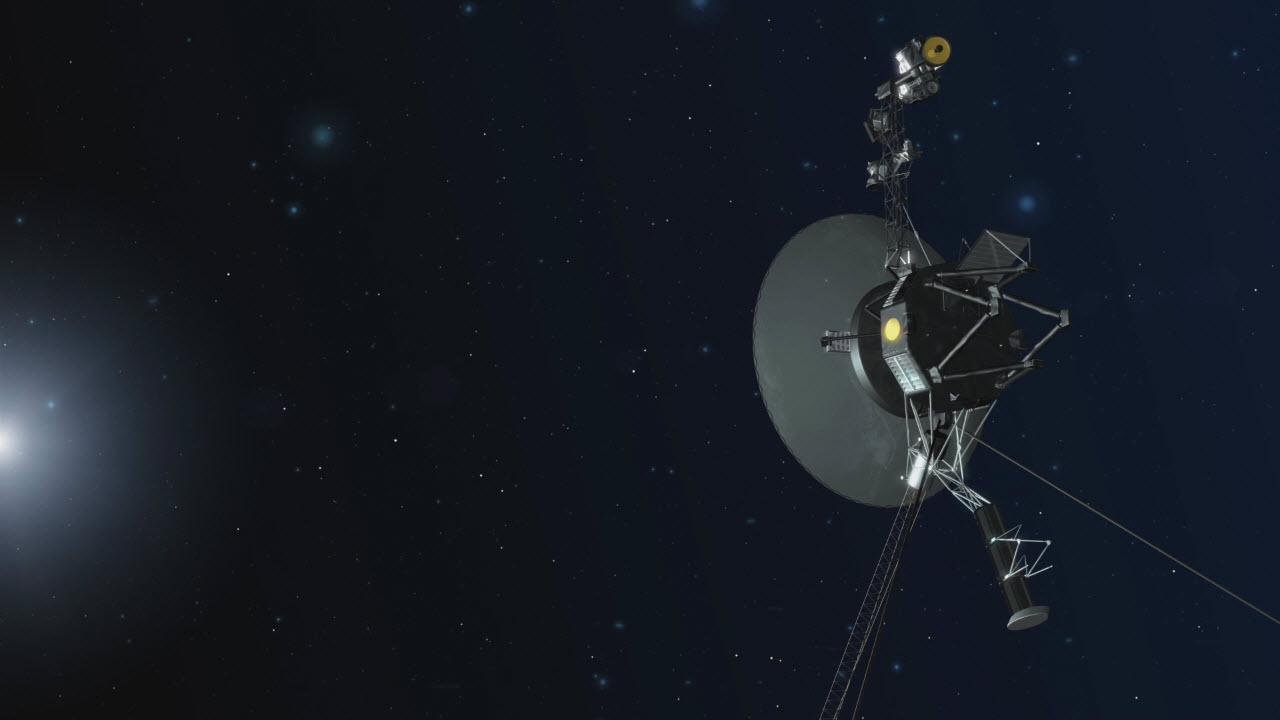
An artist concept depicting one of NASA's twin Voyager spacecraft. Humanity's farthest and longest-lived spacecraft are celebrating 40 years in August and September 2017.
If you tried to start a car that's been sitting in a garage for decades, you might not expect the engine to respond. But a set of thrusters aboard the Voyager 1 spacecraft successfully fired up Wednesday after 37 years without use.
Voyager 1, NASA's farthest and fastest spacecraft, is the only human-made object in interstellar space, the environment between the stars. The spacecraft, which has been flying for 40 years, relies on small devices called thrusters to orient itself so it can communicate with Earth. These thrusters fire in tiny pulses, or "puffs," lasting mere milliseconds, to subtly rotate the spacecraft so that its antenna points at our planet. Now, the Voyager team is able to use a set of four backup thrusters, dormant since 1980.
"With these thrusters that are still functional after 37 years without use, we will be able to extend the life of the Voyager 1 spacecraft by two to three years," said Suzanne Dodd, project manager for Voyager at NASA's Jet Propulsion Laboratory, Pasadena, California.
Since 2014, engineers have noticed that the thrusters Voyager 1 has been using to orient the spacecraft, called "attitude control thrusters," have been degrading. Over time, the thrusters require more puffs to give off the same amount of energy. At 13 billion miles from Earth, there's no mechanic shop nearby to get a tune-up.
The Voyager team assembled a group of propulsion experts at NASA's Jet Propulsion Laboratory, Pasadena, California, to study the problem. Chris Jones, Robert Shotwell, Carl Guernsey and Todd Barber analyzed options and predicted how the spacecraft would respond in different scenarios. They agreed on an unusual solution: Try giving the job of orientation to a set of thrusters that had been asleep for 37 years.
"The Voyager flight team dug up decades-old data and examined the software that was coded in an outdated assembler language, to make sure we could safely test the thrusters," said Jones, chief engineer at JPL.
In the early days of the mission, Voyager 1 flew by Jupiter, Saturn, and important moons of each. To accurately fly by and point the spacecraft's instruments at a smorgasbord of targets, engineers used "trajectory correction maneuver," or TCM, thrusters that are identical in size and functionality to the attitude control thrusters, and are located on the back side of the spacecraft. But because Voyager 1's last planetary encounter was Saturn, the Voyager team hadn't needed to use the TCM thrusters since November 8, 1980. Back then, the TCM thrusters were used in a more continuous firing mode; they had never been used in the brief bursts necessary to orient the spacecraft.
All of Voyager's thrusters were developed by Aerojet Rocketdyne. The same kind of thruster, called the MR-103, flew on other NASA spacecraft as well, such as Cassini and Dawn.
On Tuesday, Nov. 28, 2017, Voyager engineers fired up the four TCM thrusters for the first time in 37 years and tested their ability to orient the spacecraft using 10-millisecond pulses. The team waited eagerly as the test results traveled through space, taking 19 hours and 35 minutes to reach an antenna in Goldstone, California, that is part of NASA's Deep Space Network.
Lo and behold, on Wednesday, Nov. 29, they learned the TCM thrusters worked perfectly -- and just as well as the attitude control thrusters.
"The Voyager team got more excited each time with each milestone in the thruster test. The mood was one of relief, joy and incredulity after witnessing these well-rested thrusters pick up the baton as if no time had passed at all," said Barber, a JPL propulsion engineer.
The plan going forward is to switch to the TCM thrusters in January. To make the change, Voyager has to turn on one heater per thruster, which requires power -- a limited resource for the aging mission. When there is no longer enough power to operate the heaters, the team will switch back to the attitude control thrusters.
The thruster test went so well, the team will likely do a similar test on the TCM thrusters for Voyager 2, the twin spacecraft of Voyager 1. The attitude control thrusters currently used for Voyager 2 are not yet as degraded as Voyager 1's, however.
Voyager 2 is also on course to enter interstellar space, likely within the next few years.
The Voyager spacecraft were built by JPL, which continues to operate both. JPL is a division of Caltech in Pasadena. The Voyager missions are a part of the NASA Heliophysics System Observatory, sponsored by the Heliophysics Division of the Science Mission Directorate in Washington. For more information about the Voyager spacecraft, visit:
https://www.nasa.gov/voyager
https://voyager.jpl.nasa.gov
News Media Contact
Elizabeth Landau Jet Propulsion Laboratory, Pasadena, Calif. 818-354-6425 [email protected] 2017-310
You Might Also Like


News | September 5, 2022
Nasa celebrates 45 years of voyager 1, enabled by radioisotope power.
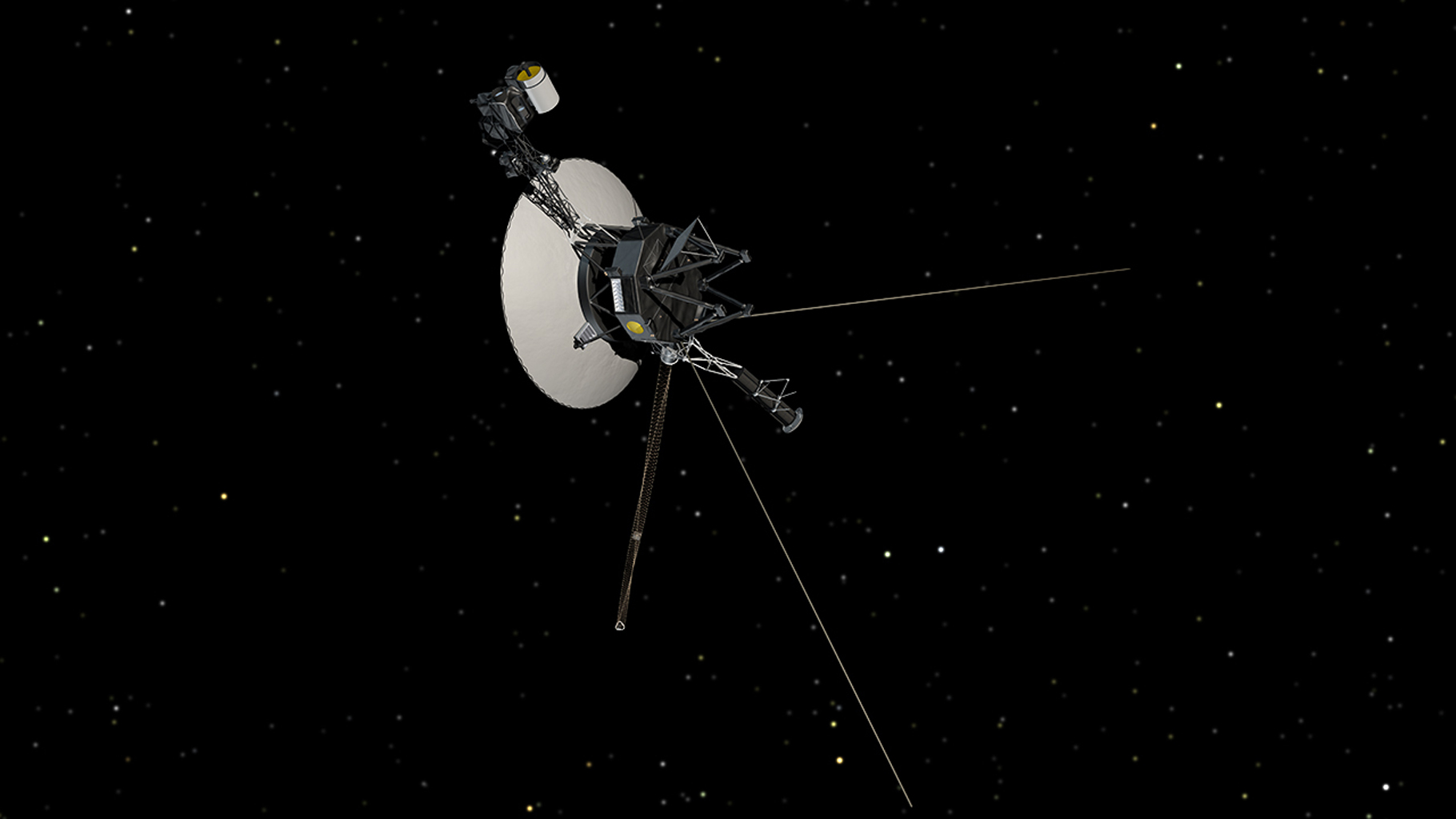
This artist’s concept shows NASA’s Voyager spacecraft against a backdrop of stars. Credit: NASA
Radioisotope Power Systems (RPS) have provided the power to explore some of the deepest, darkest, and most distant destinations in the solar system and beyond. Voyager 1 is NASA’s furthest traveled spacecraft, and its science mission has been enabled by RPS for 45 years.
On Sept. 5, NASA will be celebrating the anniversary of the Voyager 1 launch that was managed by NASA's Glenn Research Center’s (formerly NASA Lewis) Launch Vehicles Program Office, and launched out of Cape Canaveral on a Titan IIIE-Centaur rocket. The Voyager Mission was designed and is managed by NASA’s Jet Propulsion Laboratory . Voyager is NASA’s longest operating mission, thanks to the enabling power and heat from its RPS, and the twin probes are the first spacecraft to explore interstellar space.
Each probe is equipped with 3 RPS called Multi-Hundred Watt (MHW) Radioisotope Thermoelectric Generators (RTGs). Each MHW RTG generated and output of 158 Watts electric at the beginning of mission, offering Voyager about 474 watts of electricity to power its science payload. The RTGs convert heat from the natural decay of plutonium oxide into useable power to power the spacecraft. The excess heat is used to warm the instrumentation enabling them to work in the coldness of space. This production decreases over time, as the radioisotope reaches its half-life of ~87 years. The Voyager team has strategically turned off non-essential systems to extend the life of the mission as much as possible.
Forty-five years later, the RTGs are producing about 230 watts of electricity and the spacecraft is still providing valuable science returns from interstellar space. The spacecraft will continue to use the heat and power from the RTG until the output diminishes too much to support the instruments and critical systems. The Radioisotope Power System (RPS) used by Voyager 1 have enabled the spacecraft to explore some of the most distant destinations in our solar system and it was the first to begin exploring interstellar space. With over sixty years of successful use in the United States, RPS will continue to provide NASA the power to explore our solar system and beyond .
by Kristin Jansen, NASA Glenn Research Center
You Might Also Like


Learning Space
Teachable Moments
Stay Connected

Teachable Moments | August 29, 2017
The farthest operating spacecraft, voyagers 1 and 2, still exploring 40 years later.
By Ota Lutz
In the News
This year marks the 40th anniversary of the launch of the world’s farthest and longest-lived spacecraft, NASA’s Voyager 1 and 2. Four decades ago, they embarked on an ambitious mission to explore the giant outer planets, the two outermost of which had never been visited. And since completing their flybys of Jupiter, Saturn, Uranus and Neptune in 1989, they have been journeying toward the farthest reaches of our solar system – where no spacecraft has been before. These two intrepid spacecraft continue to return data to NASA daily, offering a window into the mysterious outer realms of our solar system and beyond.
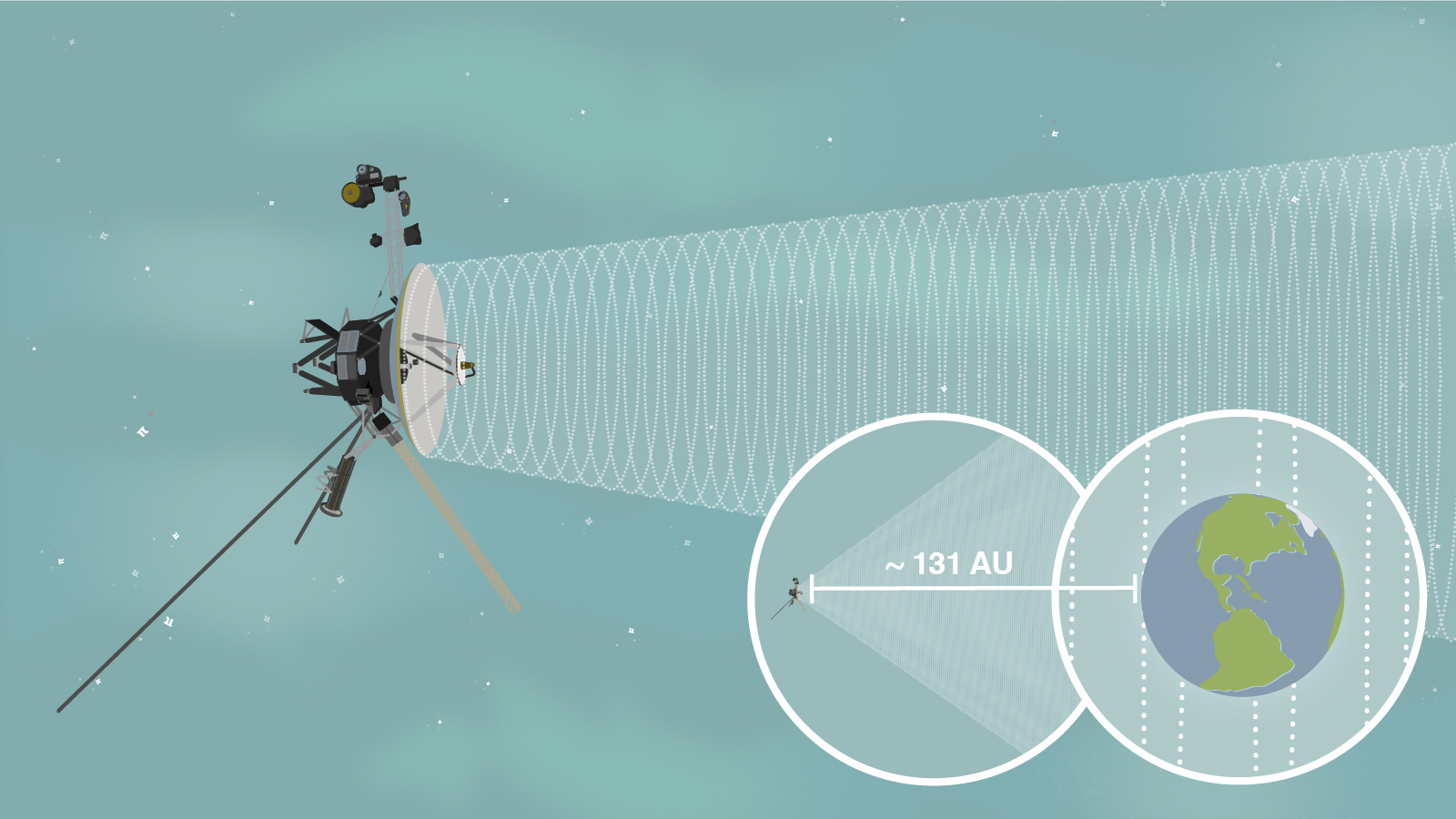
Try these standards-aligned lessons and activities with students to bring the wonder of the Voyager mission to your classroom or education group.
How They Did It
The Voyager spacecraft were launched during a very short window that took advantage of a unique alignment of the four giant outer planets – one that would not occur again for another 176 years. (Try this lesson in calculating launch windows to get an idea of how it was done.) Launching at this point in time enabled the spacecraft to fly by all four planets in a single journey, returning never-before-seen, close-up images and scientific data from Jupiter, Saturn, Uranus and Neptune that greatly contributed to our current understanding of these planets and the solar system.
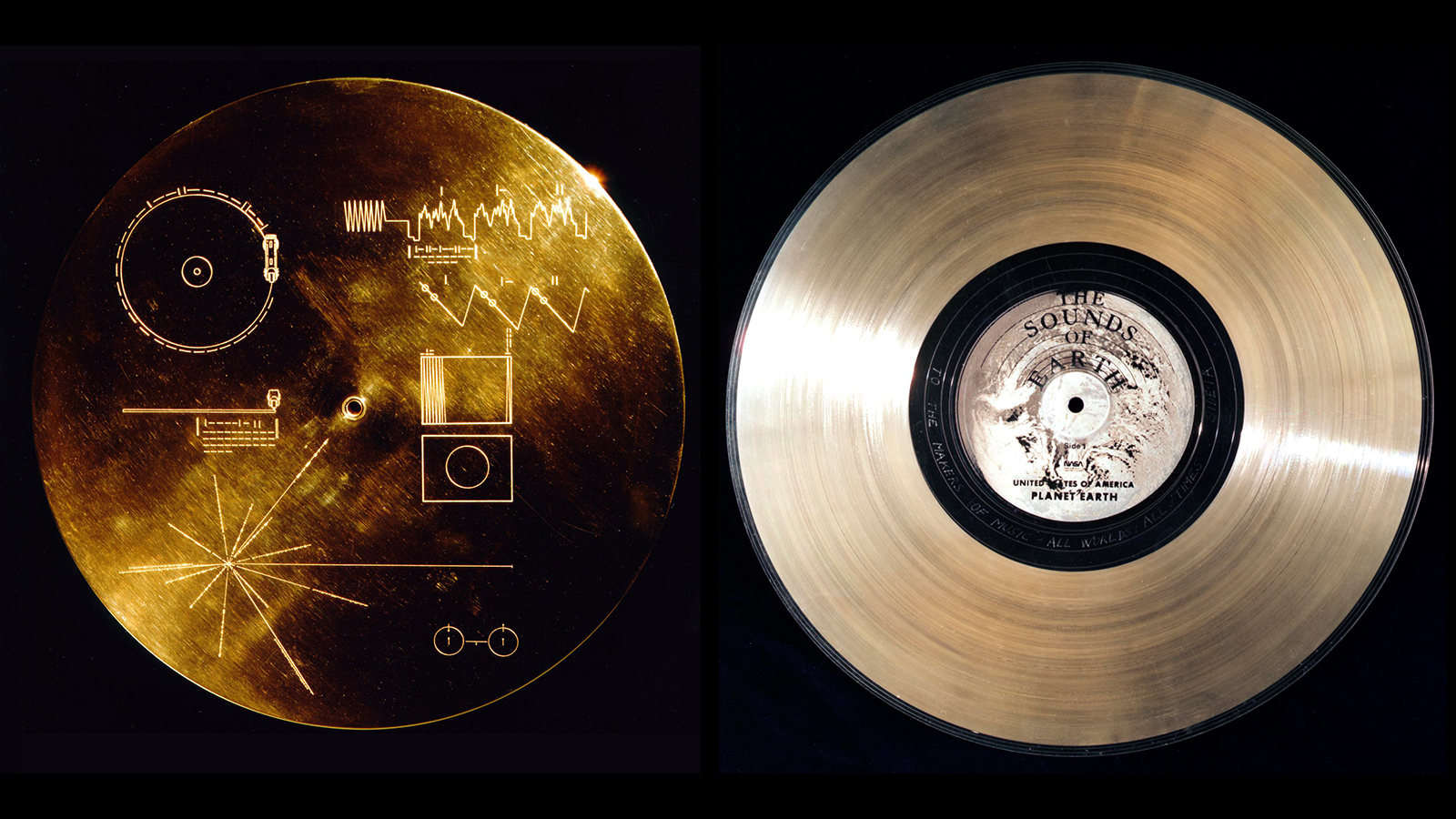
Why It’s Important

These images of Jupiter, Saturn, Uranus and Neptune (clockwise from top) were taken by Voyager 1 and 2 as the spacecraft journeyed through the solar system. See a gallery of images that Voyager took on the Voyager website. Credit: NASA/JPL-Caltech
In addition to shaping our understanding of the outer planets, the Voyager spacecraft are helping us learn more about the space beyond the planets – the outer region of our solar system. After completing their “ grand tour ” of the outer planets, the Voyagers continued on an extended mission to the outer solar system. They are now more than 10 billion miles from Earth, exploring the boundary region between our planetary system and what’s called interstellar space.
The beginning of interstellar space is where the constant flow of material from the Sun and its magnetic field stop influencing the surroundings. Most of the Sun’s influence is contained within the heliosphere, a bubble created by the Sun and limited by forces in interstellar space. (Note that the heliosphere doesn’t actually look like a sphere when it travels through space; it’s more of a blunt sphere with a tail.) The outer edge of the heliosphere, before interstellar space, is a boundary region called the heliopause. The heliopause is the outermost boundary of the solar wind , a stream of electrically charged atoms, composed primarily of ionized hydrogen, that stream outward from the Sun. Our planetary system lies inside the bubble of the heliosphere, bordered by the heliopause and surrounded by interstellar space.
Though we’ve learned a lot about the heliopause thanks to the Voyager spacecraft, its thickness and variation are still key unanswered questions in space physics. As the Voyagers continue their journey, scientists hope to learn more about the location and properties of the heliopause.
From their unique vantage points – Voyager 1 in the northern hemisphere and Voyager 2 in the southern hemisphere – the spacecraft have already detected differences and asymmetries in the solar wind termination shock, where the wind abruptly slows as it approaches the heliopause. For example, Voyager 2 crossed the termination shock at a distance of about 83.7 AU in the southern hemisphere. (One AU, or astronomical unit, is equal to 150 kilometers (93 million miles), the distance between Earth and the Sun.) That’s about 10 AU closer to the Sun than where Voyager 1 crossed the shock in the north. As shown in this diagram , Voyager 1 traveled through the compressed “nose” of the termination shock and Voyager 2 is expected to travel through the flank of the termination shock.
With four remaining powered instruments on Voyager 1 and five remaining powered instruments on Voyager 2 , the two spacecraft continue to collect science data comparing their two distinct locations at the far reaches of the solar system.
In August 2012, Voyager 1 detected a dramatic increase in galactic cosmic rays (as shown in this animated chart). The increase, which has continued to the current peak, was associated with the spacecraft's crossing into interstellar space. Credit: NASA/JPL-Caltech
Since it launched from Earth in 1977, Voyager 1 has been using an instrument to measure high-energy, dangerous particles traveling through space called galactic cosmic rays. While studying the interaction between the bubble of the heliosphere and interstellar space, Voyager 1 revealed that the heliosphere is functioning as a radiation shield, protecting our planetary system from most of these galactic cosmic rays. So in August 2012, when Voyager 1 detected a dramatic increase in the rays, which has continued to the current peak, it was associated with the spacecraft’s crossing into interstellar space.
Meanwhile, Voyager 2 – which is still in the heliosheath, the outermost layer of the heliosphere between the shock and the heliopause – is using its solar wind instrument to measure the directional change of solar wind particles there. Within the next few years, Voyager 2 is also expected to cross into interstellar space, providing us with even more detailed data about this mysterious region.
In another 10 years, we expect one or both Voyagers to cruise outward into a more pristine region of interstellar space, returning data to inform our hypotheses about the concentration of galactic particles and the characteristics of interstellar wind.
Even with 40 years of space flight behind them, the Voyagers are expected to continue returning valuable data until about 2025. Communications will be maintained until the spacecraft’s nuclear power sources can no longer supply enough electrical energy to power critical functions. Until then, there’s still much to learn about the boundary of our heliosphere and what lies beyond in the space between the stars.
Use these standards-aligned lessons and related activities to get students doing math and science with a real-world (and space!) connection.
- Hear Here - Students use the mathematical constant pi and information about the current location of Voyager 1 to learn about the faint data-filled signal being returned to Earth.
- Solar System Bead Activity – Students calculate and construct a scale model of solar system distances using beads and string.
- Catching a Whisper from Space – Students kinesthetically model the mathematics of how NASA communicates with spacecraft.
Explore More
- Voyager Mission
- Voyager Images
- Voyager Golden Record
- The Sounds of Interstellar Space
- Voyager Senses Sun's Tsunami Wave in Interstellar Medium
- Commemorative Voyager Posters
TAGS: Voyager , Farthest , Golden Record , STEM , Teachable Moments , Science , Engineering , Solar System , Interstellar Space , Heliopause , Heliosphere , Heliosheath , Termination Shock , Stars , Heliophysics

Ota Lutz , K-12 Education Group Manager, NASA-JPL Education Office
Ota Lutz is the manager of the K-12 Education Group at NASA’s Jet Propulsion Laboratory. When she’s not writing new lessons or teaching, she’s probably cooking something delicious, volunteering in the community, or dreaming about where she will travel next.
Voyager 1 talking to Earth again after NASA engineers 24 billion kilometres away devise software fix
NASA's Voyager 1 probe — the most distant man-made object in the universe — is returning usable information to ground control following months of spouting gibberish, the US space agency says.
The spaceship stopped sending readable data back to Earth on November 14, 2023, even though controllers could tell it was still receiving their commands.
In March, teams working at NASA's Jet Propulsion Laboratory discovered that a single malfunctioning chip was to blame.
They then had to devise a clever coding fix that worked within the tight memory constraints of its 46-year-old computer system.
"There was a section of the computer memory no longer working," project leader Dr Linda Spilker told the ABC.
"So we had to reprogram what was in that memory, move it to a different location, link everything back together and send everything up in a patch.
"And then on Saturday morning, we watched as Voyager 1 sent its first commands back and we knew we were back in communication once again."
Dr Spilker said they were receiving engineering data, so they knew the health and safety of the spacecraft.
"The next step is going to be to develop a patch so we can send back the science data," she said.
"That will really be exciting, to once again learn about interstellar space and what has been going on there that we've missed since November."
Dr Spilker said Voyager sent back data in real time, so the team had no facility to retrieve data covering the time since transmission was lost.
Launched in 1977, Voyager 1 was mankind's first spacecraft to enter the interstellar medium , in 2012, and is currently more than 24 billion kilometres from Earth.
Messages sent from Earth take about 22.5 hours to reach the spacecraft.
Its twin, Voyager 2, also left the solar system in 2018 as it was tracked by Australia's Parkes radio telescope.
Australia was also vital to a 2023 search for Voyager 2 after signals were lost, with Canberra's Deep Space Communication Complex monitoring for signals and then sending a successful command to shift the spacecraft's antenna 2 degrees .
Both Voyager spacecraft carry " Golden Records ": 12-inch, gold-plated copper disks intended to convey the story of our world to extraterrestrials.
These include a map of our solar system, a piece of uranium that serves as a radioactive clock allowing recipients to date the spaceship's launch, and symbolic instructions that convey how to play the record.
The contents of the record, selected for NASA by a committee chaired by legendary astronomer Carl Sagan, include encoded images of life on Earth, as well as music and sounds that can be played using an included stylus.
Their power banks were expected to be depleted sometime after 2025, but Dr Spilker said several systems had been turned off, so they were hopeful the two spacecraft would function into the 2030s.
They will then continue to wander the Milky Way, potentially for eternity, in silence.
- X (formerly Twitter)
Related Stories
Nasa restores contact with missing voyager 2 spacecraft after weeks of silence.
How songs from tiny villages in the Pacific are now floating in outer space
Voyager 1 spacecraft enters interstellar space
- Astronomy (Space)
- Computer Science
- Space Exploration
- United States

IMAGES
VIDEO
COMMENTS
In the SVG file, hover over a trajectory or orbit to highlight it and its associated launches and flybys. Voyager 1 is a space probe launched by NASA on September 5, 1977, as part of the Voyager program to study the outer Solar System and the interstellar space beyond the Sun's heliosphere.
Note: Because Earth moves around the sun faster than Voyager 1 is speeding away from the inner solar system, the distance between Earth and the spacecraft actually decreases at certain times of year. Distance from Sun: This is a real-time indicator of Voyagers' straight-line distance from the sun in astronomical units (AU) and either miles (mi ...
Voyager 1 has been exploring our solar system for more than 45 years. The probe is now in interstellar space, the region outside the heliopause, or the bubble of energetic particles and magnetic fields from the Sun. Voyager 1 is the first human-made object to venture into interstellar space. Voyager 1 discovered a thin ring around Jupiter and ...
The probe and its twin, Voyager 2, are the only spacecraft to ever fly in interstellar space (the space between stars). Voyager 1 stopped sending readable science and engineering data back to Earth on Nov. 14, 2023, even though mission controllers could tell the spacecraft was still receiving their commands and otherwise operating normally.
Mission Overview. The twin Voyager 1 and 2 spacecraft are exploring where nothing from Earth has flown before. Continuing on their more-than-40-year journey since their 1977 launches, they each are much farther away from Earth and the sun than Pluto. In August 2012, Voyager 1 made the historic entry into interstellar space, the region between ...
The identical Voyager spacecraft are three-axis stabilized systems that use celestial or gyro referenced attitude control to maintain pointing of the high-gain antennas toward Earth. ... 1977, from Cape Canaveral, Florida aboard a Titan-Centaur rocket. On September 5, Voyager 1 launched, also from Cape Canaveral aboard a Titan-Centaur rocket ...
About the mission. Voyager 1 reached interstellar space in August 2012 and is the most distant human-made object in existence. Launched just shortly after its twin spacecraft, Voyager 2, in 1977, Voyager 1 explored the Jovian and Saturnian systems discovering new moons, active volcanoes and a wealth of data about the outer solar system.
Voyager 1 lifted off on Sept. 5, 1977, atop a Titan IIIE-Centaur rocket from Launch Complex 41 at Cape Canaveral Air Force Station, now Cape Canaveral Space Force Station, in Florida. Two weeks after its launch, from a distance of 7.25 million miles, Voyager 1 turned its camera back toward its home planet and took the first single-frame image ...
Voyager 1 and its twin Voyager 2 are the only spacecraft ever to operate outside the heliosphere, the protective bubble of particles and magnetic fields generated by the Sun. Voyager 1 reached the interstellar boundary in 2012, while Voyager 2 (traveling slower and in a different direction than its twin) reached it in 2018. Mission Type.
Voyager 1 is one of two identical space probes. Voyager 2, launched two weeks before Voyager 1, is now about 13 billion miles from Earth, the two crafts' trajectories having diverged somewhere ...
The first such fix was transmitted to Voyager 1 on April 18. With a total distance of 30 billion miles to cross from Earth to the spacecraft and back, the team had to wait nearly two full days for ...
Voyager 1 is the first spacecraft to travel beyond the solar system and enter interstellar space. The probe is still exploring the cosmos to this day. ... as its rocket came within 3.5 seconds of ...
NASA's venerable Voyager 1 spacecraft has reached a key milestone. The Voyager 1 probe launched 45 years ago, on Sept. 5, 1977, just weeks after its twin Voyager 2 but soon overtaking it. The two ...
Voyager 1 was part of a twin-spacecraft mission with Voyager 2. The twin-spacecraft mission took advantage of a rare orbital positioning of Jupiter, Saturn, Uranus, and Neptune that permitted a multiplanet tour with relatively low fuel requirements and flight time. The alignment allowed each spacecraft, following a particular trajectory, to use its fall into a planet's gravitational field to ...
Launched nearly 47 years ago, Voyager 1 is flying on an outbound trajectory more than 15 billion miles (24 billion kilometers) from Earth, and it takes 22-and-a-half hours for a radio signal to ...
At approximately 2:10 p.m. Pacific time on February 17, 1998, Voyager 1, launched more than two decades ago, will cruise beyond the Pioneer 10 spacecraft and become the most distant human-created object in space at 10.4 billion kilometers (6.5 billion miles.) The two are headed in almost opposite directions away from the Sun.
On Saturday, April 5, Voyager 1 finally "phoned home" and updated its NASA operating team about its health. The interstellar explorer is back in touch after five months of sending back nonsense data.
The Voyagers have set numerous records in their unparalleled journeys. In 2012, Voyager 1, which launched on Sept. 5, 1977, became the only spacecraft to have entered interstellar space. Voyager 2, launched on Aug. 20, 1977, is the only spacecraft to have flown by all four outer planets - Jupiter, Saturn, Uranus and Neptune.
The Voyager 1 and Voyager 2 probes launched in 1977 on a mission to study Jupiter and Saturn but continued onward through the outer reaches of the solar system. In 2012, Voyager 1 became the first ...
This is a real-time indicator of Voyager 1's distance from Earth in astronomical units (AU) and either miles (mi) or kilometers (km). Note: Because Earth moves around the sun faster than Voyager 1 is speeding away from the inner solar system, the distance between Earth and the spacecraft actually decreases at certain times of year.
The Pale Blue Dot is a photograph of Earth taken Feb. 14, 1990, by NASA's Voyager 1 at a distance of 3.7 billion miles (6 billion kilometers) from the Sun. NASA/JPL-Caltech. Voyager 1, meanwhile ...
Voyager 1's flight data system collects information from the spacecraft's science instruments and bundles it with engineering data that reflects its current health status. Mission control on ...
Learn more: Closer look at Voyager 1 and Voyager 2. Voyager 2 entered interstellar space − the space between the stars, starting at about 11 billion miles from our sun − in 2018. It's now 12.7 ...
This illustration provided by NASA depicts Voyager 1. The most distant spacecraft from Earth stopped sending back understandable data in November 2023. Flight controllers traced the blank communication to a bad computer chip and rearranged the spacecraft's coding to work around the trouble. In mid-April 2024, NASA's Jet Propulsion ...
Voyager Goals & Accomplishments. Voyager 1 and 2 were designed to take advantage of a rare planetary alignment to explore the outer solar system. Voyager 1 targeted Jupiter and Saturn before continuing on to chart the far edges of our solar system. Voyager 2 targeted Jupiter, Saturn, Uranus and Neptune before joining its sister probe on their ...
NASA. The Voyager 1 aboard the Titan III/Centaur lifted off on September 5, 1977, joining its sister spacecraft, the Voyager 2, on a mission to the outer planets. NASA's Voyager 1 spacecraft launched atop its Titan/Centaur-6 launch vehicle from the Kennedy Space Center Launch Complex in Florida on September 5, 1977, at 8:56 a.m. local time.
On Tuesday, Nov. 28, 2017, Voyager engineers fired up the four TCM thrusters for the first time in 37 years and tested their ability to orient the spacecraft using 10-millisecond pulses. The team waited eagerly as the test results traveled through space, taking 19 hours and 35 minutes to reach an antenna in Goldstone, California, that is part ...
On Sept. 5, NASA will be celebrating the anniversary of the Voyager 1 launch that was managed by NASA's Glenn Research Center's (formerly NASA Lewis) Launch Vehicles Program Office, and launched out of Cape Canaveral on a Titan IIIE-Centaur rocket. The Voyager Mission was designed and is managed by NASA's Jet Propulsion Laboratory. Voyager ...
In the NewsThis year marks the 40th anniversary of the launch of the world's farthest and longest-lived spacecraft, NASA's Voyager 1 and 2. Four decades ago, they embarked on an ambitious mission to explore the giant outer planets, the two outermost of which had never been visited. And since completing their flybys of Jupiter, Saturn, Uranus and Neptune in 1989, they have been journeying ...
Launched in 1977, Voyager 1 was mankind's first spacecraft to enter the interstellar medium, in 2012, and is currently more than 24 billion kilometres from Earth.. Messages sent from Earth take ...